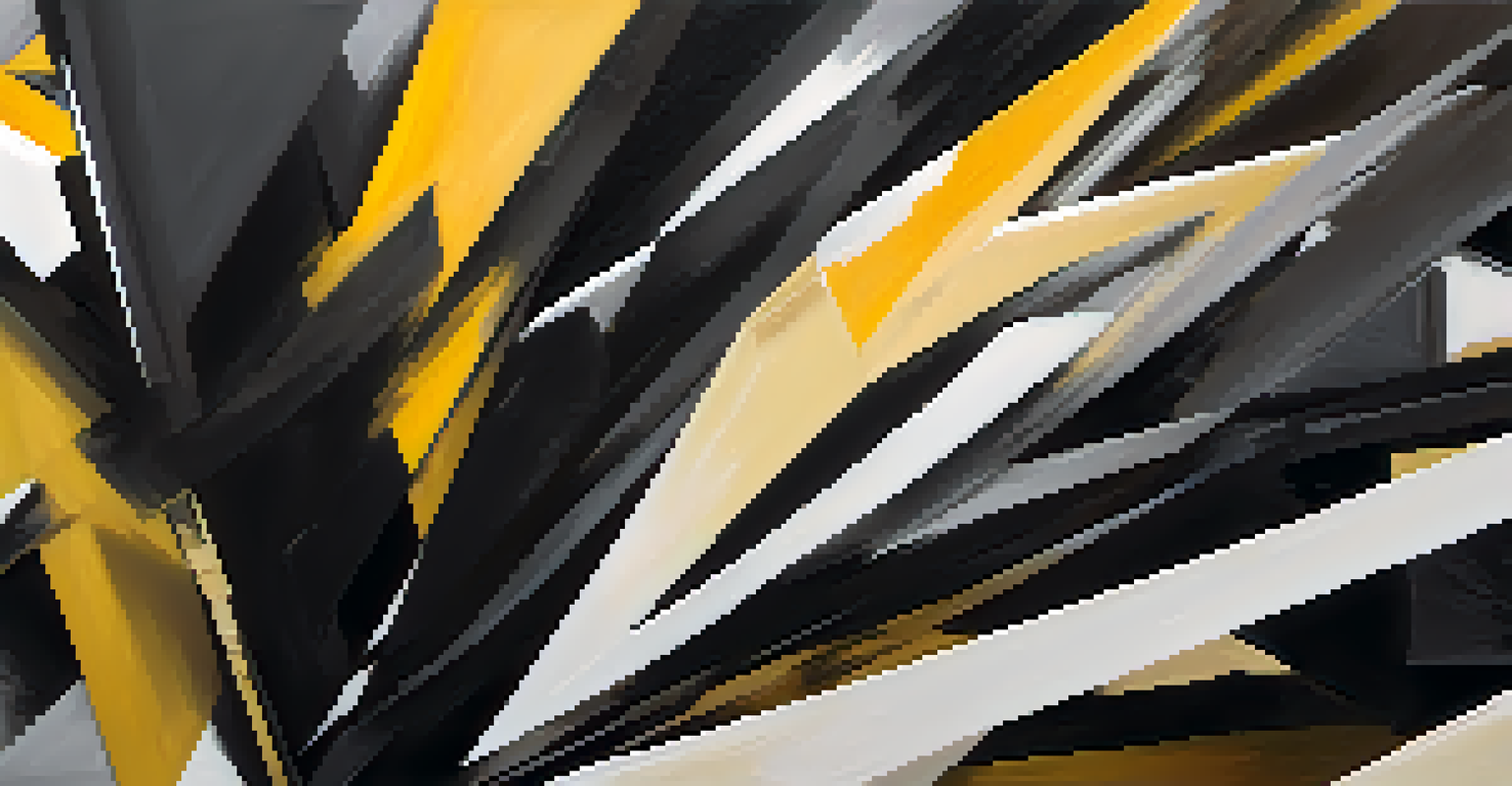The Role of Emotion in Abstract Painting Narratives

Understanding Abstract Painting and Its Emotional Depth
Abstract painting often defies traditional representation, inviting viewers into a realm where emotion reigns supreme. These artworks don't depict recognizable subjects; instead, they rely on colors, shapes, and forms, evoking feelings and sensations. This emotional depth allows artists to communicate complex narratives that resonate on a personal level.
Abstract art is not a visual form; it is a way of thinking about and organizing the world.
For instance, a chaotic swirl of reds and blacks might ignite feelings of anger or turmoil, while soft blues and greens can evoke serenity and calm. Each viewer may interpret these colors differently based on their own experiences, illustrating how abstract art serves as a mirror to our emotions. This subjective nature of perception is what makes abstract painting so captivating and profound.
In essence, understanding the emotional core of abstract painting requires us to look beyond the surface. It challenges us to engage with the artwork on an emotional level, allowing for a more profound comprehension of the narrative being presented through abstract forms.
The Artist's Emotional Journey in Creating Abstraction
Every abstract painting is a reflection of the artist's emotional journey, often serving as a cathartic outlet. The process of creating art can be an intimate exploration of one's feelings, fears, and hopes. As artists pour their emotions onto the canvas, they craft narratives that echo their inner world, transforming personal experiences into universal themes.

For example, an artist grappling with loss may create a piece filled with dark hues and jagged lines, capturing the rawness of grief. This emotional expression is not just about the final piece; it's about the journey of creation itself, where each brushstroke conveys a fragment of the artist's psyche. This connection between the artist and their work adds layers of meaning to the narrative.
Emotions Drive Abstract Art's Impact
Abstract painting uses colors and shapes to evoke personal feelings, allowing viewers to connect emotionally with the artwork.
Thus, the emotional journey is not only pivotal to the artist but also to the viewer's experience. When we engage with an abstract piece, we are invited to share in the artist's emotional exploration, creating a bond that transcends words and speaks directly to our feelings.
Emotions as a Narrative Device in Abstract Art
In abstract painting, emotions often serve as a powerful narrative device. Rather than telling a story through recognizable imagery, abstract artists use emotional resonance to convey themes and messages. This unique approach enables the audience to interpret the artwork based on their emotional responses, fostering a personal connection.
Art is the most beautiful of all lies; it is the truth that hides behind the illusion.
Take, for instance, a painting filled with vibrant yellows and oranges, suggesting joy and vitality. The narrative might revolve around themes of hope, renewal, or celebration, even without explicit imagery. This method invites viewers to engage with the piece actively, as they project their emotions onto the canvas, crafting their own interpretations.
Consequently, the emotional narratives embedded within abstract art can vary widely from one viewer to another. This diversity of interpretation enriches the experience, making abstract paintings not just artworks, but interactive narratives that unfold uniquely for each individual.
The Impact of Color on Emotional Narratives in Art
Color plays a crucial role in shaping the emotional narratives of abstract paintings. Different colors evoke distinct feelings—red can symbolize passion or anger, while blue often represents calmness or sadness. Artists strategically choose their color palettes to convey specific emotions, guiding the viewer's emotional journey through the artwork.
For example, a painting dominated by cool tones might evoke a sense of tranquility, inviting the viewer to relax and reflect. Conversely, an explosion of warm colors can create an atmosphere of energy and excitement. This intentional use of color transforms the canvas into a narrative of emotions, allowing viewers to experience a spectrum of feelings.
Artist's Journey Reflects in Art
The creation of abstract art serves as a cathartic outlet for artists, where their emotional journeys manifest in the narratives woven into their work.
Understanding the emotional language of color enriches our appreciation of abstract art. By recognizing how colors influence our perception, we can deepen our engagement with the narratives that unfold within each piece, enhancing our overall experience.
Personal Experiences Shaping Abstract Art Narratives
Personal experiences significantly influence the emotional narratives within abstract paintings. Artists often draw from their own life stories, using their art to express feelings that might be difficult to articulate. This connection to personal experiences adds authenticity and depth to the narratives they create.
For instance, an artist who has experienced joy, heartbreak, or transformation may infuse these emotions into their work, creating pieces that resonate with others who have faced similar feelings. This shared emotional language enables viewers to connect with the artwork on a personal level, as they see their own experiences reflected in the abstract forms.
Ultimately, the interplay between personal experiences and abstract narratives allows for a rich dialogue between the artist and the audience. As viewers, we are invited to explore our emotions, fostering a deeper understanding of both the artwork and ourselves.
Cultural Context and Emotional Interpretation in Abstract Art
Cultural context plays a significant role in shaping the emotional narratives of abstract paintings. Different cultures have unique ways of expressing emotions, and these influences can be seen in the choices artists make regarding color, form, and composition. Understanding the cultural background of an abstract piece can enhance our appreciation of its emotional depth.
For example, an artist from a culture that emphasizes harmony and balance may create artwork that reflects these values through soothing colors and symmetrical forms. In contrast, an artist from a culture that embraces chaos might use bold colors and dynamic shapes to convey intensity and passion. These cultural nuances provide layers of meaning that enrich the narrative.
Viewers Shape Art's Emotional Narrative
The interpretation of abstract art is subjective, with each viewer projecting their own experiences and emotions onto the piece, creating a unique interaction.
Therefore, when engaging with abstract art, it's essential to consider the cultural influences at play. By doing so, we can better understand the emotional narratives that are often deeply rooted in the artist's background, leading to a more holistic appreciation of the artwork.
The Viewer’s Role in Shaping Abstract Art Narratives
The viewer plays a pivotal role in shaping the emotional narratives of abstract paintings. Unlike traditional art forms that may dictate a specific story, abstract art invites viewers to bring their own experiences and emotions into the interpretation. This interaction transforms the artwork into a collaborative narrative between the artist and the audience.
For instance, one viewer might see a burst of colors as a celebration of life, while another might interpret the same piece as a reflection of chaos and uncertainty. This subjective engagement allows abstract art to resonate on multiple levels, making each encounter unique and personal. It’s this dynamic interaction that keeps abstract art relevant and powerful.

In essence, the viewer's emotional response is as significant as the artist's intention. By embracing this collaborative narrative, we open ourselves up to a richer understanding of abstract art, allowing it to speak to us in ways that are deeply personal and transformative.